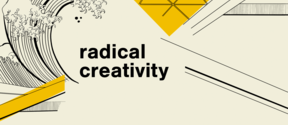Radical creativity
We enable experimental activities that challenge the status quo.

Have you recently experienced total concentration and involvement in an activity at work? When was the last time you felt satisfaction after completing a challenging task?
Those moments were your experiences of creative flow that motivated you to return to the respective activities again and again and improved your performance.
Flow is a state of consciousness when you feel complete absorption in a task, like reading an interesting paper or answering a call for papers. This concept was coined by psychologist Mihaly Csikszentmihalyi in the 1960’s when he studied the creative process of painters. He was impressed by the fact that the artist was determined to continue painting despite feeling hungry or tired. So, he got interested in understanding this subjective phenomenon of intrinsically motivated activities.
After studying people such as chess players, rock climbers and composers, Csikszentmihalyi concluded that flow occurs when an individual deals with a challenge at the right level of complexity for their personal level of expertise. Later Csikszentmihalyi and his colleagues extended the research by interviewing engineers, business people, physicians and other professionals from less creative domains.
How to recognize the state of flow?
How about you? How can you say you found your certain way of flow? You know you entered the cognitive state of flow in work activities when these four characteristics sound familiar:
You may ask, to what extent have I experienced any of these four mental states at low, medium, or high intensity? But it doesn’t matter whether you experienced low or high-intensity flow. What counts is that you have found a way to enjoy your work. The more often you experience flow, the more likely you’ll gain higher performance.
If you don’t relate to the above-mentioned experiences, do not panic. It’s time to learn how to create for yourself the conditions for flow to happen and thus increase the moments of creative production in everyday work life.
Achieving a state of creative flow
In an academic setting, your creative process begins with a moment of serendipity, when you identify a new research question that can be transformed into a successful publication. Then you enter the preparation phase when you build the knowledge, skills and information that enable you to address the identified problem. How could you set up the contexts that transition you to flow experiences throughout this preparation stage?
Here are four suggestions:
Prepare your mind. After roughtly 60 years of neurobiological research, studies have started to show that during flow experiences the brain releases norepinephrine and dopamine - neurotransmitters that drive us to act more and consider less the risk of our actions. A light physical activity, like slow walking, can be a suitable precedent to amp up your energy and set the right mood for achieving flow. Alternatively, listening to an uplifting tune or any activity you enjoy with no effort can warm your mind up for an intense mental activity.
Make a list of research areas that intrigue you, but you don’t necessarily have master knowledge of. These are areas of specialization in which you have not published a paper yet. Choose a topic which you are interested in addressing, but which you think can be a stretch for your existing competence.
Set a goal for yourself. You can, e.g., select three of the most recent and relevant papers to decide to read them within a time frame of, say, 2 hours.
Aim at balance between the complexity of the read material and your abilities. If you feel frustrated or anxious, the level of the content of the paper is too high for your skills. If you feel bored, the challenge is too low. For the remaining time you gave yourself for this task, don’t be afraid to discard the paper and to look for another one that catches your attention.
These four steps can be taken during any other higher-difficulty activity you’d like more frequently and intensely to experience flow with.
On a scale of 1 to 5 (I frequently found my mind wandering elsewhere - I think I forgot to breathe), how absorbed were you while reading this article? The higher your score, the more likely you’re an innately curious person, which helps a great deal to find flow in academic environments.
Entering a state of flow is a matter of discipline. Staying in it relies on subjectively perceived opportunities and abilities for action. Select an activity that triggers your interest and is complex enough to keep you engaged, but not too complex to frustrate you. Set a goal for the activity and a duration to perform it.
Don’t panic when you don’t feel the flow. Stay focused on what you know well and what you’re interested in knowing.

We enable experimental activities that challenge the status quo.

Social sustainability in practice.
Flow can also be achieved jointly with others!